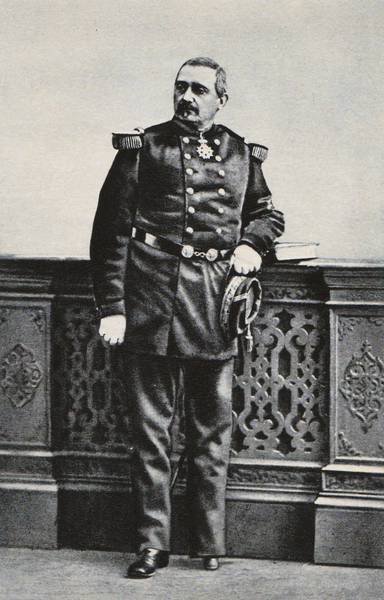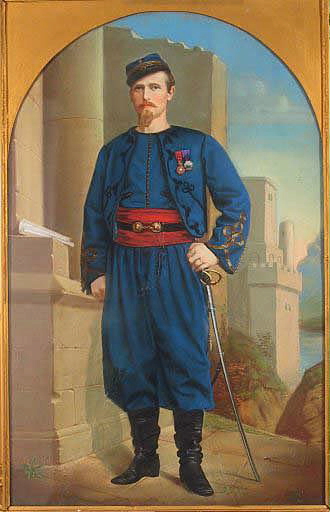The Pere Doussot added: “I was walking between General de Sonis and Colonel de Charette. We spoke together of the great and only means of safety for France and her army—that of becoming frankly Christian. Then M. de Sonis said, pointing to his banner carried by one of his Spahis, ‘That is why I put the sign you see on my flag!” It was a white cross on a blue ground. ‘But, General,’ exclaimed Charette, ‘I should like some more distinctly religious emblem.’ ‘You are quite right,’ replied de Sonis; ‘this heraldic device does not speak enough of Jesus Christ. I had a crucifix painted on it at first; but it was so badly done, I could not keep it.’ ‘Well,’ answered de Charette, ‘I have got just what you want.’ He then began to tell us of a magnificent banner, richly embroidered by the Nuns at Paray-le-Monial, of the Sacred Heart, which had been laid on the tomb of Blessed Margaret Mary. Their intention was to send it to General Trochu, so that it might float on the ramparts of Paris; but on sending it for that purpose to M. Dupont at Tours, they heard that Paris was then so invested by the Germans that it was not possible to forward it there. Then they said it was to be for the legion of Volunteers from the west. M. de Charette had just obtained leave to place his sword and that of his Pontifical Zouaves at the service of France; so that M. Dupont considered that they were the most entitled to the banner, and sent it to them”
M. de Sonis was delighted at this story. “Well,” he exclaimed, “as it is for your Zouaves that it was destined, one of them ust bring it to me. You shall choose him, and he must be the bearer of my new colours.” …
We were gathered together in the great hall when M. de Charette came in with a tall, fair youth, with a charming countenance; this was the young Count Henri de Verthamon, an old defender of the Pope, and already the father of two little children, whom he had left to serve as a Volunteer in the French army.

The Flag of Sacre-Coeur, borne by the Pontifical Zouaves who fought (victoriously) at Patay, had been first placed overnight in St. Martin’s Tomb before being taken into battle on October 9, 1870. The banner read “Heart of Jesus Save France” and on the reverse side Carmelite Nuns of Tours embroidered “Saint Martin Protect France”.
‘General,’ exclaimed M. de Charette, touching the shoulder of his young companion, ‘here is the bearer of your new colours, and here is the banner.’ Saying this, M. de Charette handed me a great roll, which when opened displayed a beautiful banner such as is carried in processions. It was of white moiré silk, embroidered in gold bearing in the center the Sacred Heart of Jesus in red velvet. Above and below the image were the words: ‘Heart of Jesus, save France!
The life of General de Sonis, from his papers and correspondence by Baunard, Mgr., 1826-1919; Herbert, Mary Elisabeth À Court Herbert, Baroness, 1822-1911, p.192-3
Short Stories on Honor, Chivalry, and the World of Nobility—no. 666











